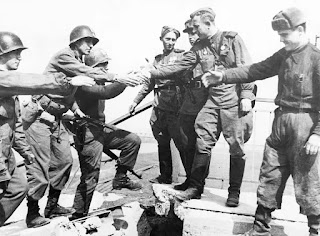Photos from the historic meeting on Elbe River between American and Soviet troops, 1945
Photos from the historic meeting on Elbe River between American and Soviet troops, 1945
These iconic photographs were taken the day Soviet and American troops met at the Elbe River, near Torgau in Germany, marking an important step toward the end of World War II in Europe.
The first image shows American Lieutenant William Robertson and Soviet Lieutenant Alexander Silvashko with their arms around each other, smiling, in front of their national flags.
The picture of Robertson and Silvashko was taken on April 26th, the day after the meeting. Other shots show soldiers shaking hands, exchanging souvenirs, and posing for photographs.
This contact between the Soviets, advancing from the east, and the Americans, advancing from the west, meant that the two powers had effectively cut Germany in two.
The first contact between American and Soviet patrols occurred near Strehla, after First Lieutenant Albert Kotzebue, an American soldier, crossed the River Elbe in a boat with three men from an intelligence and reconnaissance platoon.
On the east bank, they met forward elements of a Soviet Guards rifle regiment of the First Ukrainian Front, under the command of Lieutenant Colonel Alexander Gordeyev.
The same day, another patrol under Second Lieutenant William Robertson with Frank Huff, James McDonnell and Paul Staub met a Soviet patrol commanded by Lieutenant Alexander Silvashko on the destroyed Elbe bridge of Torgau.
On April 26, the commander of the 69th Infantry Division of the First Army, Emil F. Reinhardt, and the commander of the 58th Guards Rifle Division of the 5th Guards Army, Vladimir Rusakov, met at Torgau, southwest of Berlin.
Arrangements were made for the formal “Handshake of Torgau” between Robertson and Silvashko in front of photographers the following day, April 27.
American President Harry S. Truman welcomed the news: “This is not the hour of final victory in Europe, but the hour draws near, the hour for which all the American people, all the British people, and all the Soviet people have toiled and prayed so long.”
Joseph Stalin spoke of the war still ahead: “Our task and our duty are to complete the destruction of the enemy to force him to lay down his arms and surrender unconditionally. The Red Army will fulfill to the end this task and this duty to our people and to all freedom-loving peoples.”
The Soviet, American, British, and French governments released simultaneous statements that evening in London, Moscow, and Washington, reaffirming the determination of the three Allied powers to complete the destruction of the Third Reich.
Even though the Allies had cut Germany in half, Hitler ordered his soldiers to fight on, before committing suicide on April 30th.
In the years since, monuments to the Elbe link-up were built at Torgau, Lorenzkirch, and Bad Liebenwerda. There’s also a “Spirit of the Elbe” plaque at Arlington National Cemetery.
During the Cold War, the link-up was frequently cited as a reminder for peace and friendship between the US and the Soviet Union.
One of the soldiers present at the link-up petitioned the UN to make April 25 a “World Day of Peace,” though it was never officially declared.
Russia later issued a coin commemorating the 50th anniversary of the event. In 2010, the US and Russian presidents issued a joint statement honoring April 25 and the “spirit of the Elbe.”











.webp)
















Comments
Post a Comment